What is Releuko?
Releuko is a man-made form of granulocyte colony-stimulating factor (G-CSF). G-CSF is a substance produced by the body. It stimulates the growth of neutrophils, a type of white blood cell important in the body’s fight against infection.
Who should not use Releuko?
Do not take Releuko if you have had a serious allergic reaction to human G-CSFs such as filgrastim products or pegfilgrastim products.
What should I tell my healthcare provider before using Releuko?
Before you take Releuko, tell your healthcare provider about all of your medical conditions, including if you:
- have a sickle cell disorder.
- have kidney problems.
- are receiving radiation therapy.
- are pregnant or plan to become pregnant. It is not known if Releuko will harm your unborn baby.
- are breastfeeding or plan to breastfeed. It is not known if Releuko passes into your breast milk.
Tell your healthcare provider about all the medicines you take, including prescription and over-the-counter medicines, vitamins, and herbal supplements.
How should I use Releuko?
- Releuko injections can be given by a healthcare provider by intravenous (IV) infusion or under your skin (subcutaneous injection). Your healthcare provider may decide subcutaneous injections can be given at home by you or your caregiver. If Releuko is given at home, see the detailed “Instructions for Use” that comes with your Releuko for information on how to prepare and inject a dose of Releuko.
- You and your caregiver should be shown how to prepare and inject Releuko before you use it, by your healthcare provider.
- You should not try to inject a dose of Releuko less than 0.3 mL (180 mcg) from a Releuko prefilled syringe. A dose less than 0.3 mL cannot be accurately measured using the Releuko prefilled syringe.
- Your healthcare provider will tell you how much Releuko to inject and when to inject it. Do not change your dose or stop Releuko unless your healthcare provider tells you to.
- If you are receiving Releuko because you are also receiving chemotherapy, your dose of Releuko should be injected at least 24 hours before or 24 hours after your dose of chemotherapy. Your healthcare provider will do blood tests to monitor your white blood cell count, and if necessary, adjust your Releuko dose.
- If you miss a dose of Releuko, talk to your healthcare provider about when you should give your next dose.
What are the possible side effects of Releuko?
Releuko may cause serious side effects, including:
- Spleen rupture. Your spleen may become enlarged and can rupture. A ruptured spleen can cause death. Call your healthcare provider right away if you have pain in the left upper stomach (abdomen) area or your left shoulder.
- A serious lung problem called acute respiratory distress syndrome (ARDS). Call your healthcare provider or get emergency medical help right away if you have shortness of breath with or without a fever, trouble breathing, or a fast rate of breathing.
- Serious allergic reactions. Releuko can cause serious allergic reactions. These reactions can cause a rash over your whole body, shortness of breath, wheezing, dizziness, swelling around your mouth or eyes, fast heart rate, and sweating. If you have any of these symptoms, stop using Releuko and call your healthcare provider or get emergency medical help right away.
- Sickle cell crises. You may have a serious sickle cell crisis, which could lead to death, if you have a sickle cell disorder and receive Releuko. Call your healthcare provider right away if you have symptoms of sickle cell crisis such as pain or difficulty breathing.
- Kidney injury (glomerulonephritis). Releuko can cause kidney injury. Call your healthcare provider right away if you develop any of the following symptoms:
- swelling of your face or ankles
- blood in your urine or dark colored urine
- you urinate less than usual
- Capillary leak syndrome. Releuko can cause fluid to leak from blood vessels into your body’s tissues. This condition is called “Capillary Leak Syndrome” (CLS). CLS can quickly cause you to have symptoms that may become life-threatening. Get emergency medical help right away if you develop any of the following symptoms:
- swelling or puffiness and are urinating less than usual
- trouble breathing
- swelling of your stomach area (abdomen) and feeling of fullness
- dizziness or feeling faint
- a general feeling of tiredness
- Myelodysplastic syndrome (MDS) and acute myeloid leukemia (AML).
- Releuko may increase the risk of developing a precancerous condition called MDS or a type of blood cancer called AML in people who were born with low white blood cell counts (congenital neutropenia).
- If you have breast cancer or lung cancer, when Releuko is used with chemotherapy and radiation therapy, or with radiation therapy only, you may have an increased risk of developing MDS or AML.
- Symptoms of MDS and AML may include tiredness, fever, and easy bruising or bleeding.
- Call your healthcare provider if you develop any of these symptoms during treatment with Releuko.
- Decreased platelet count (thrombocytopenia). Your healthcare provider will check your blood during treatment with Releuko. Tell your healthcare provider if you have unusual bleeding or bruising during treatment with Releuko. This could be a sign of decreased platelet counts, which may reduce the ability of your blood to clot.
- Increased white blood cell count (leukocytosis). Your healthcare provider will check your blood during treatment with Releuko.
- Inflammation of your blood vessels (cutaneous vasculitis). Tell your healthcare provider right away if you develop purple spots or redness of your skin.
- Inflammation of the aorta (aortitis). Inflammation of the aorta (the large blood vessel which transports blood from the heart to the body) has been reported in patients who received filgrastim products. Symptoms may include fever, abdominal pain, feeling tired, and back pain. Call your healthcare provider if you experience these symptoms.
The most common side effects experienced in patients receiving Releuko include:
- Patients with cancer receiving chemotherapy: fever, pain, rash, cough, and shortness of breath
- Patients with acute myeloid leukemia receiving chemotherapy: pain, nose bleed, and rash
- Patients with cancer receiving chemotherapy followed by bone marrow transplant: rash
- Patients with severe chronic neutropenia: pain, decreased red blood cells, nose bleed, diarrhea, reduced sensation, and hair loss
These are not all the possible side effects of Releuko. Call your healthcare provider for medical advice about side effects. You may report side effects to FDA at 1-800-FDA-1088.
General information about the safe and effective use of Releuko
Medicines are sometimes prescribed for purposes other than those listed in a Patient Information leaflet. Do not use Releuko for a condition for which it was not prescribed. Do not give Releuko to other people, even if they have the same symptoms that you have. It may harm them. You can ask your pharmacist or healthcare provider for information about Releuko that is written for healthcare professionals.
How should I store Releuko?
- Store Releuko in the refrigerator between 36°F to 46°F (2°C to 8°C).
- Do not freeze.
- Keep Releuko in the original pack to protect from light or physical damage. Do not leave Releuko in direct sunlight.
- Do not shake Releuko.
- Take Releuko out of the refrigerator 30 minutes before use and allow it to reach room temperature before preparing an injection.
- Throw away (dispose of) any Releuko that has been left at room temperature for longer than 24 hours.
- After you inject your dose, throw away (dispose of) any unused Releuko left in the vials or prefilled syringes. Do not save unused Releuko in the vials or prefilled syringes for later use.
Keep Releuko and all medicines out of the reach of children.
What are the ingredients in Releuko?
Active ingredient: filgrastim-ayow
Inactive ingredients: acetic acid, polysorbate 80, sodium hydroxide, sorbitol and water for injection
For more information go to www.Releuko.us or call 1-877-835-5472.
Instructions for use for Releuko
Releuko (reh-loo-koe)
(filgrastim-ayow)
Injection
Single-Dose Vial
Important
Read the Patient Information for important information you need to know about Releuko before using these Instructions for Use.
Before you use a Releuko vial, read this important information:
Storing your Releuko vial
- Store the vial in the refrigerator between 36˚F to 46˚F (2˚C to 8˚C).
- Do not freeze.
- Keep the vial in the original pack to protect from light or physical damage.
- Take the vial out of the refrigerator 30 minutes before use and allow it to reach room temperature before preparing an injection.
- Throw away (dispose of) any vial that has been left at room temperature for longer than 24 hours.
- After you inject your dose, throw away (dispose of) any unused Releuko left in the vial. Do not save unused Releuko in the vial for later use.
- Keep Releuko and all medicines out of the reach of children.
Using your vial
- It is important that you do not try to give the injection unless you or your caregiver has received training from your healthcare provider.
- Make sure the name Releuko appears on the pack and vial label.
- Only use the vial 1 time. Discard (throw away) the vial with any remaining Releuko liquid.
- Do not use a vial after the expiration date on the label.
- Do not shake the vial.
- Do not use the vial if the medicine is cloudy or discolored or contains flakes or particles.
Call your healthcare provider if you have any questions.
Step 1: Prepare
A Remove the vial from the refrigerator.
On a clean, well-lit surface, place the vial at room temperature for 30 minutes before you give an injection.
- Do not try to warm the vial by using a heat source such as hot water or microwave.
- Do not leave the vial in direct sunlight.
- Do not shake the vial.
- Use the vial only 1 time.
B Inspect the vial.
Make sure the medicine in the vial is clear and colorless.
- Do not use the vial if:
- The medicine is cloudy or discolored or contains flakes or particles.
- The expiration date printed on the label has passed.
- In all cases, use a new vial and call your healthcare provider.
C Gather all materials needed for your injection.
Wash your hands thoroughly with soap and water.
On a clean, well-lit work surface, place the:
- 1 Vial
- 1 Disposable syringe and needle
- 2 alcohol wipes
- 1 Cotton ball or gauze pad
- 1 Adhesive bandage
- Sharps disposal container
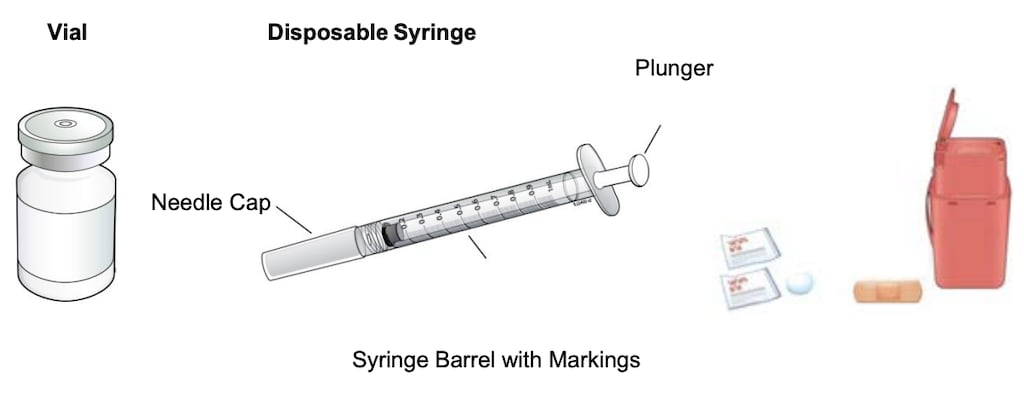
- Only use the disposable syringes and needles that your healthcare provider prescribes.
- Only use the syringes and needles 1 time. Discard (throw away) any used syringes and needles. See Step 5 Finish, for instructions about how to properly dispose of used syringes and needles.
- You should only use a syringe that is marked in tenths of milliliters (mL).
- Your healthcare provider will show you how to measure the correct dose of Releuko. This dose will be measured in milliliters (mL).
Step 2: Get Ready
D Take the cap off the vial. Clean the rubber stopper with one alcohol wipe.
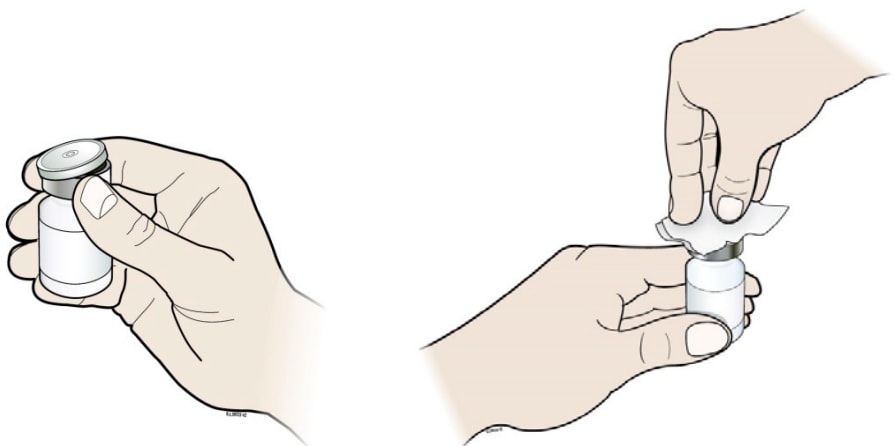
E Check the carton containing the syringe. If the carton has been opened or damaged, do not use that syringe. Dispose of (throw away) that syringe in the sharps disposal container.
F Hold the syringe by the barrel with the needle cap pointing up. Carefully pull the needle cap straight off and away from your body.
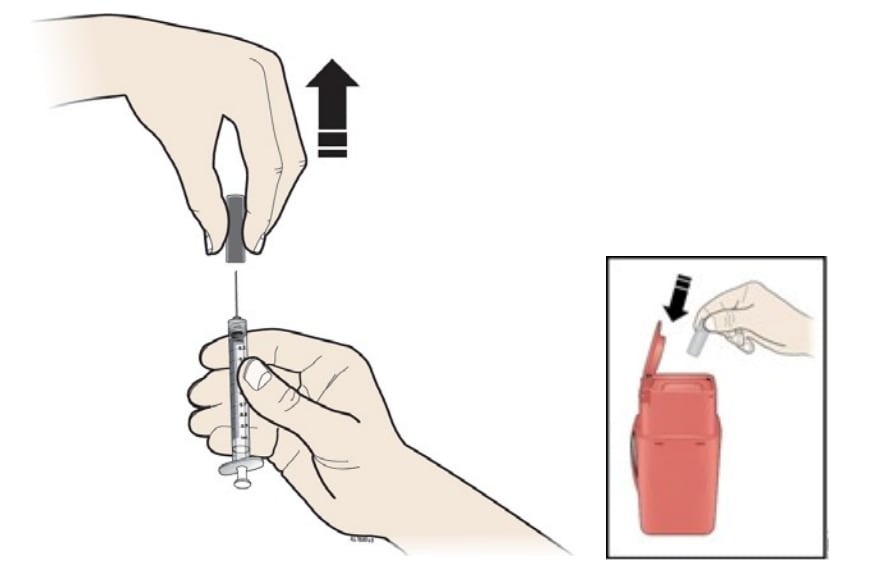
Pull back on the plunger and draw air into the syringe that is the same amount (mL) as the dose of Releuko that your healthcare provider prescribed.
Important: Throw the needle cap into the sharps disposal container. Do not recap the needle.
G Keep the vial on the flat working surface and insert the needle straight down through the rubber stopper. Do not insert the needle through the rubber stopper more than 1 time.
H Push the plunger down and inject all the air from the syringe into the vial of Releuko.
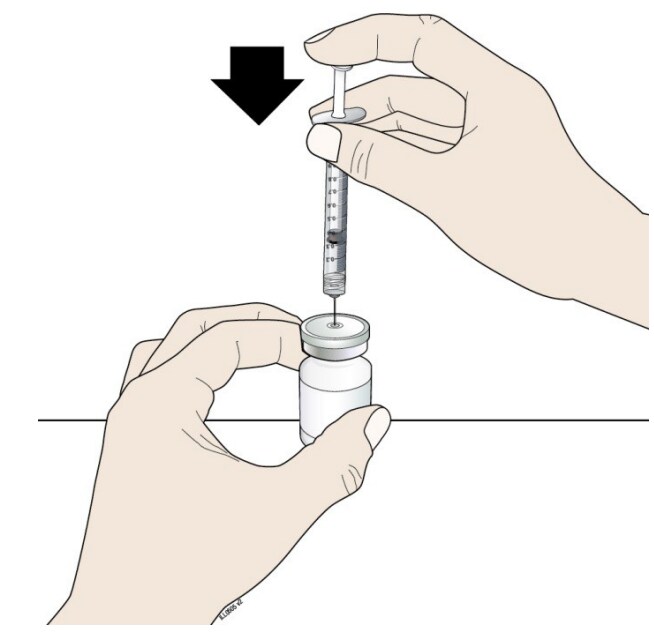
I Keep the needle in the vial and turn the vial upside down. Make sure that the Releuko liquid is covering the tip of the needle.
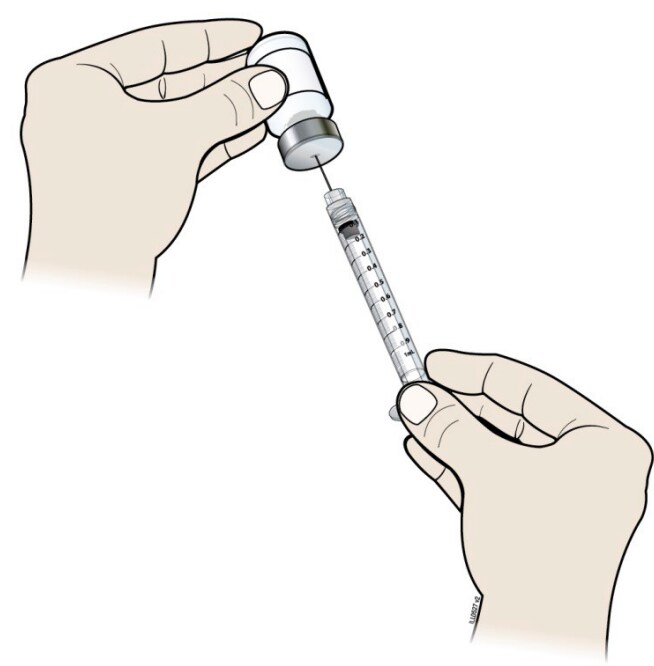
J Keep the vial upside down and slowly pull back on the plunger to fill the syringe barrel with Releuko to the correct marking amount (mL) of medicine that matches the dose your healthcare provider prescribed.
K Keep the needle in the vial and check for air bubbles in the syringe. If there are air bubbles, gently tap the syringe barrel with your finger until the air bubbles rise to the top. Slowly push the plunger up to push the air bubbles out of the syringe.
L Keep the tip of the needle in the liquid and again pull the plunger back to the number on the syringe barrel that matches your dose. Check again for air bubbles. The air in the syringe will not hurt you, but too large an air bubble can reduce your dose of Releuko. If there are still air bubbles, repeat the steps above to remove them.
M Check again to make sure that you have the correct dose in the syringe. It is important that you use the exact dose prescribed by your healthcare provider. Do not remove the needle from the vial. Lay the vial down on its side with the needle still in the vial.
Step 3: Select and Prepare the Injection Site
N Prepare and clean your injection site.
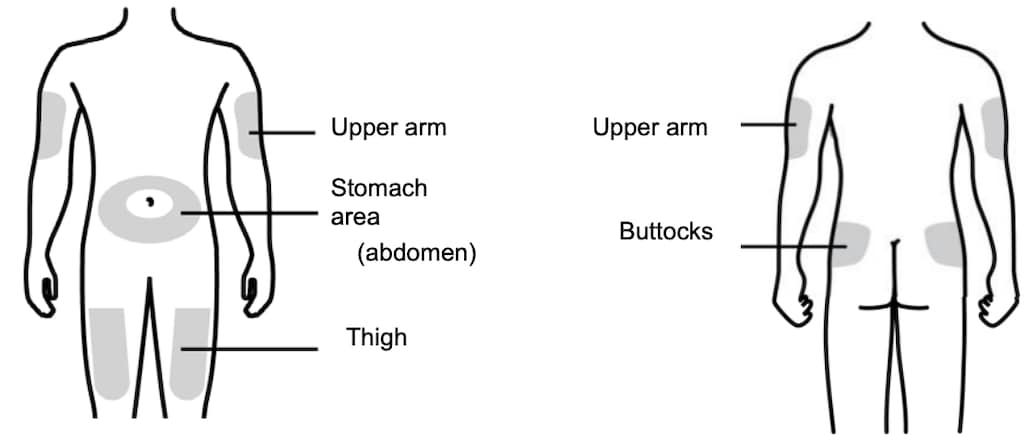
You can use:
- Thigh
- Stomach area (abdomen), except for a 2-inch area right around your navel (belly button)
- Upper outer area of your buttocks (only if someone else is giving you the injection)
- Outer area of upper arm (only if someone else is giving you the injection)
Clean your injection site with a clean alcohol wipe.
- Let your skin dry.
- Do not touch this area again before injecting.
- If you want to use the same injection site, make sure it is not the same spot on the injection site area you used for a previous injection.
- Do not inject into areas where the skin is tender, bruised, red, or hard. Avoid injecting into areas with scars or stretch marks.
Step 4: Subcutaneous (under the skin) injection
O Remove the prepared syringe and needle from the vial.
P Pinch your injection site to create a firm surface.
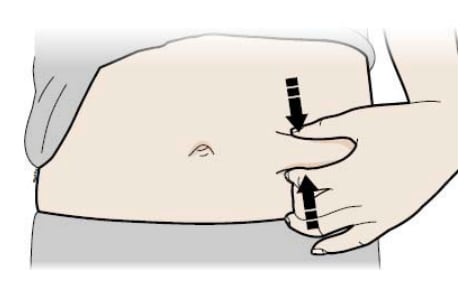
Important: Keep skin pinched while injecting.
Q Hold the pinch. Insert the needle into the skin at a 45 to 90 degree angle.
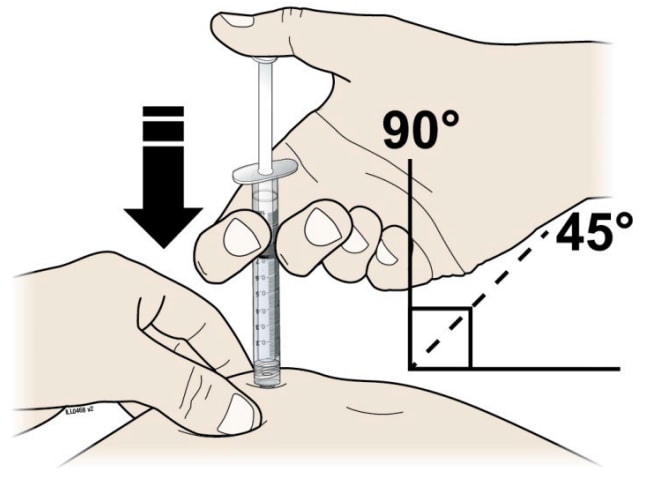
R Using slow and constant pressure, push the plunger until it reaches the bottom.
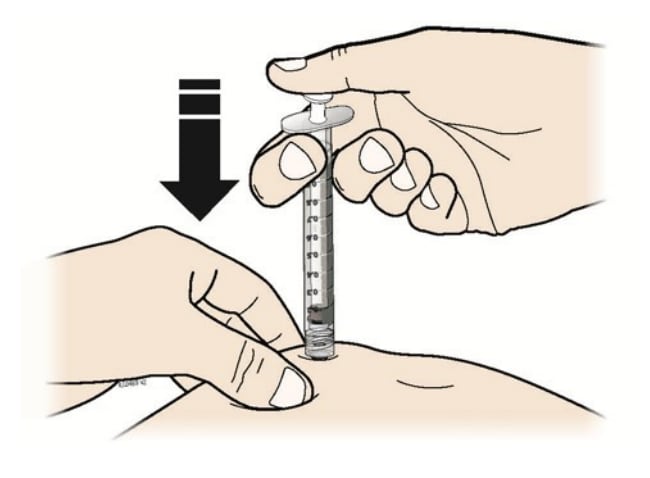
When done, gently pull the needle out of the injection site at the same 45 to 90 degree angle used to insert it.
Step 5: Finish
S Discard (throw away) the used syringe and vial.
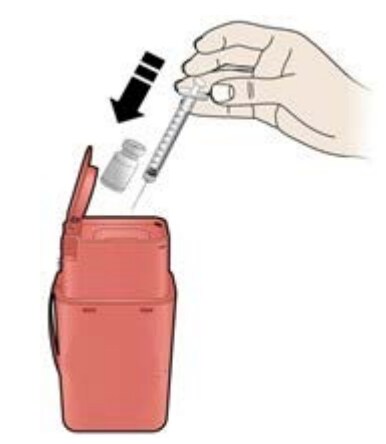
- Put your used syringes, needles, and vials in a FDA-cleared sharps disposal container right away after use. Do not throw away (dispose of) needles, syringes and vials in your household trash.
- If you do not have an FDA-cleared sharps disposal container, you may use a household container that:
- is made of a heavy-duty plastic,
- can be closed with a tight-fitting, puncture-resistant lid, without sharps being able to come out,
- is upright and stable during use,
- is leak-resistant, and
- is properly labeled to warn of hazardous waste inside the container.
- When your sharps disposal container is almost full, you will need to follow your community guidelines or the right way to dispose of your sharps disposal container. There may be state or local laws about how you should throw away used syringes and needles. For more information about safe sharps disposal, and for specific information about sharps disposal in the state that you live in, go to the FDA’s website at: http://www.fda.gov/safesharpsdisposal.
- Do not reuse the syringe or vial.
- Do not recycle the syringe, vial, or sharps disposal container or throw them into household trash.
Important: Always keep the sharps disposal container out of the reach of children.
T Examine the injection site.
If there is blood, press a cotton ball or gauze pad on your injection site. Do not rub the injection site. Apply an adhesive bandage if needed.
Instructions for use issued 02/2022.




